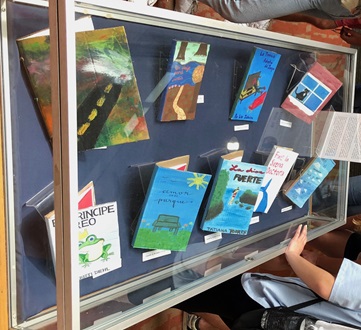Spanish Course Brings Latin American Activism to Campus With “Drexel Cartonera: Memorias al Carton”
By Liz Waldie
June 7, 2022
One might expect a written exam to wrap up their class for the quarter. But students in Celeste Dolores Mann’s Spanish 410 course—Performing Spanish: Proficiency Through the Arts—had to think outside the box for their final. Rather, they had to use the box, sourcing cardboard for their projects.
Because her course was focused on the performing arts in Latin America and Spain, and the coursework was writing-intensive, Mann decided a creative final project was the way to go.
“Considering Drexel’s emphasis on experiential learning, and since I have worked professionally in the performing arts as a singer—I wasn’t just talking about something I read about in a book but presenting performing arts as something that I have done, that has been a part of my own life—I felt that something experiential would be most appropriate for the course,” she explains.
Mann considered essays, creative writing and artwork all as possible projects, but ultimately figured that these would be difficult to grade fairly. After much thought, she gravitated toward Cartoneras—a sociopolitical art movement original to Argentina, which spread throughout much of Latin America in the mid-aughts.
Pioneered by “Eloísa Cartonera” and “Dulcinea Catadora” street publishing cooperatives, the movement started with artists, writers and cartoneros (people whose lives were built on scavenging for and selling materials to recycling plants). These street publishing co-ops would purchase cardboard from cartoneros at a higher price than recycling plants and create books with hand-painted covers. Not only did this grassroots initiative focus on recycling, it also served as a way to make books more accessible and affordable in a time when the economy was crumbling. Literature largely became more accessible to the public through book fairs and workshops hosted by these publishers in diverse communities.
Mann saw this as the perfect opportunity for her students to learn of Latin American activism while honing their Spanish skills. Students would write stories and create their own cartonera books, and the project would culminate in an exhibition. Stacy Stanislaw in Haggerty Library helped Mann realize the exhibition.
“I thought that having students write their own short stories would be a good opportunity to review the structure of a narrative,” Mann says, “and a creative vehicle that all the students, no matter what their background with the language, would be able to excel in.”

Every day throughout the winter term, students practiced their Spanish writing skills in their diario de creación (creation journal), in response to various prompts. Over time, this daily ritual fostered a sense of creativity and opened their imaginations to ideas for their final stories. Students from all different backgrounds, with or without writing or artmaking experience, created unique stories about a range of topics from children’s stories to personal memories and more.
Mann describes the class period in which students designed their own book covers as an art workshop, where they each utilized recycled cardboard and paints in primary colors (red, yellow, blue). Ultimately, the two sections of Mann’s class produced over 30 books, all of which are currently on view in Hagerty Library.
“The Cartonera Exhibition was something increíble as I might say in Spanish,” says Lily DeSimone, an English major who was enthralled by the exhibition. “As students of the language, it is impressive in itself to see others engage with Spanish by way of speaking, writing or listening, but it is another subject entirely to be creative in the target language.”
She goes on to explain her awe of those who can further their education in another language beyond grammar and structure. “These students have the ability to create and self-reflect in a language they are actively engaging in culturally—something many of us struggle with in our own native language.”
The free exhibition was originally scheduled to be on view through June 17, but has since been extended through August 29, 2022. It is not only open to the Drexel community, but to the public as well. Mann sees the exhibition as an opportunity for the community to experience the hard work and creativity that Drexel students have put into a Spanish course. Additionally, it pays homage to the Cartoneras movement in Latin America—something that is still widely unknown in the United States.
“I wanted to increase awareness of this movement, which has given lesser-known artists and writers a voice in Latin America and has created books that are outside the mainstream publishing industry, making them accessible to a wider public,” Mann says. “[Through the exhibition], we experience and see how refuse can be recycled and turned into art.”
Learn more about the exhibition and plan your visit here.